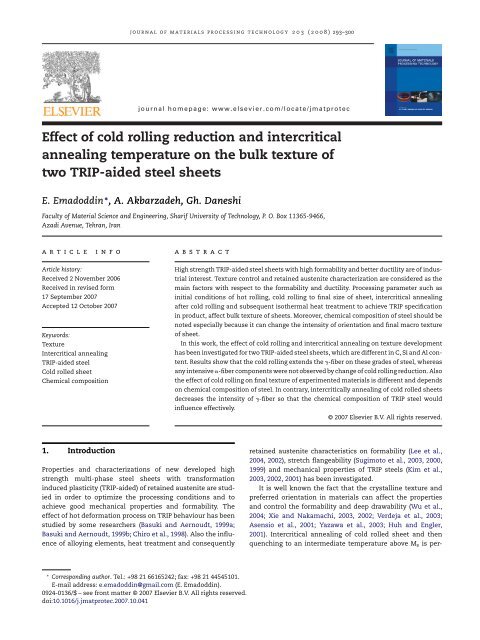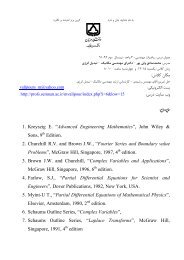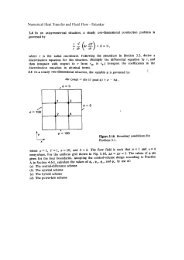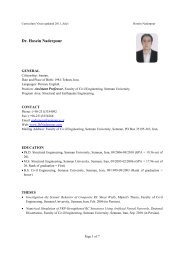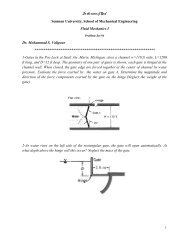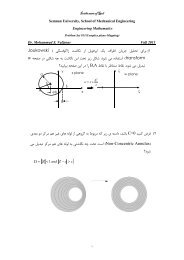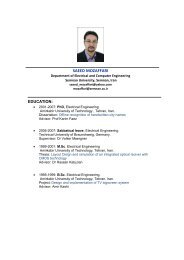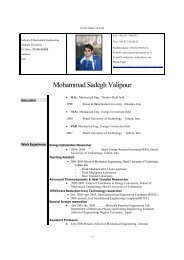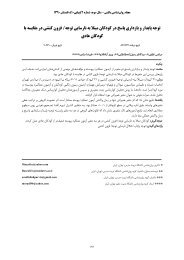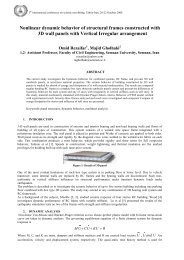Effect of cold rolling reduction and intercritical annealing ...
Effect of cold rolling reduction and intercritical annealing ...
Effect of cold rolling reduction and intercritical annealing ...
You also want an ePaper? Increase the reach of your titles
YUMPU automatically turns print PDFs into web optimized ePapers that Google loves.
journal <strong>of</strong> materials processing technology 203 (2008) 293–300journal homepage: www.elsevier.com/locate/jmatprotec<strong>Effect</strong> <strong>of</strong> <strong>cold</strong> <strong>rolling</strong> <strong>reduction</strong> <strong>and</strong> <strong>intercritical</strong><strong>annealing</strong> temperature on the bulk texture <strong>of</strong>two TRIP-aided steel sheetsE. Emadoddin ∗ , A. Akbarzadeh, Gh. DaneshiFaculty <strong>of</strong> Material Science <strong>and</strong> Engineering, Sharif University <strong>of</strong> Technology, P. O. Box 11365-9466,Azadi Avenue, Tehran, IranarticleinfoabstractArticle history:Received 2 November 2006Received in revised form17 September 2007Accepted 12 October 2007Keywords:TextureIntercritical <strong>annealing</strong>TRIP-aided steelCold rolled sheetChemical compositionHigh strength TRIP-aided steel sheets with high formability <strong>and</strong> better ductility are <strong>of</strong> industrialinterest. Texture control <strong>and</strong> retained austenite characterization are considered as themain factors with respect to the formability <strong>and</strong> ductility. Processing parameter such asinitial conditions <strong>of</strong> hot <strong>rolling</strong>, <strong>cold</strong> <strong>rolling</strong> to final size <strong>of</strong> sheet, <strong>intercritical</strong> <strong>annealing</strong>after <strong>cold</strong> <strong>rolling</strong> <strong>and</strong> subsequent isothermal heat treatment to achieve TRIP specificationin product, affect bulk texture <strong>of</strong> sheets. Moreover, chemical composition <strong>of</strong> steel should benoted especially because it can change the intensity <strong>of</strong> orientation <strong>and</strong> final macro texture<strong>of</strong> sheet.In this work, the effect <strong>of</strong> <strong>cold</strong> <strong>rolling</strong> <strong>and</strong> <strong>intercritical</strong> <strong>annealing</strong> on texture developmenthas been investigated for two TRIP-aided steel sheets, which are different in C, Si <strong>and</strong> Al content.Results show that the <strong>cold</strong> <strong>rolling</strong> extends the -fiber on these grades <strong>of</strong> steel, whereasany intensive -fiber components were not observed by change <strong>of</strong> <strong>cold</strong> <strong>rolling</strong> <strong>reduction</strong>. Alsothe effect <strong>of</strong> <strong>cold</strong> <strong>rolling</strong> on final texture <strong>of</strong> experimented materials is different <strong>and</strong> dependson chemical composition <strong>of</strong> steel. In contrary, <strong>intercritical</strong>ly <strong>annealing</strong> <strong>of</strong> <strong>cold</strong> rolled sheetsdecreases the intensity <strong>of</strong> -fiber so that the chemical composition <strong>of</strong> TRIP steel wouldinfluence effectively.© 2007 Elsevier B.V. All rights reserved.1. IntroductionProperties <strong>and</strong> characterizations <strong>of</strong> new developed highstrength multi-phase steel sheets with transformationinduced plasticity (TRIP-aided) <strong>of</strong> retained austenite are studiedin order to optimize the processing conditions <strong>and</strong> toachieve good mechanical properties <strong>and</strong> formability. Theeffect <strong>of</strong> hot deformation process on TRIP behaviour has beenstudied by some researchers (Basuki <strong>and</strong> Aernoudt, 1999a;Basuki <strong>and</strong> Aernoudt, 1999b; Chiro et al., 1998). Also the influence<strong>of</strong> alloying elements, heat treatment <strong>and</strong> consequentlyretained austenite characteristics on formability (Lee et al.,2004, 2002), stretch flangeability (Sugimoto et al., 2003, 2000,1999) <strong>and</strong> mechanical properties <strong>of</strong> TRIP steels (Kim et al.,2003, 2002, 2001) has been investigated.It is well known the fact that the crystalline texture <strong>and</strong>preferred orientation in materials can affect the properties<strong>and</strong> control the formability <strong>and</strong> deep drawability (Wu et al.,2004; Xie <strong>and</strong> Nakamachi, 2003, 2002; Verdeja et al., 2003;Asensio et al., 2001; Yazawa et al., 2003; Huh <strong>and</strong> Engler,2001). Intercritical <strong>annealing</strong> <strong>of</strong> <strong>cold</strong> rolled sheet <strong>and</strong> thenquenching to an intermediate temperature above M s is per-∗ Corresponding author. Tel.: +98 21 66165242; fax: +98 21 44545101.E-mail address: e.emadoddin@gmail.com (E. Emadoddin).0924-0136/$ – see front matter © 2007 Elsevier B.V. All rights reserved.doi:10.1016/j.jmatprotec.2007.10.041
294 journal <strong>of</strong> materials processing technology 203 (2008) 293–300Table 1 – Chemical composition <strong>and</strong> critical temperatures <strong>of</strong> experimented materialsSample code Chemical composition (in wt%) A c1 ( ◦ C) A c3 ( ◦ C)C Mn Si P S AlSi-TRIP 0.12 1.60 1.28 0.015 0.002 0.05 748 897Al-TRIP 0.27 1.48 0.28 0.015 0.001 1.08 746 970Fig.1– ϕ 2 =45 ◦ ODF section <strong>of</strong> the <strong>cold</strong> rolled Si-TRIP steelsheets after <strong>cold</strong> <strong>rolling</strong> <strong>reduction</strong> (a) 65%, (b) 76% <strong>and</strong> (c)84%.Fig.2– ϕ 2 =45 ◦ ODF section <strong>of</strong> the <strong>cold</strong> rolled Al-TRIP steelsheets after <strong>cold</strong> <strong>rolling</strong> <strong>reduction</strong> (a) 65%, (b) 76% <strong>and</strong> (c)84%.
journal <strong>of</strong> materials processing technology 203 (2008) 293–300 295the austenite phase <strong>and</strong> the bulk texture <strong>of</strong> the transformationproduct <strong>of</strong> some TRIP-aided steels. However, there arenot sufficient studies regarding the texture development during<strong>cold</strong> <strong>rolling</strong> <strong>and</strong> <strong>annealing</strong> (Oh et al., 2002; Shin et al.,2002).In this research, the macro texture <strong>of</strong> two types <strong>of</strong>TRIP-aided steels with different chemical compositions isinvestigated <strong>and</strong> the effect <strong>of</strong> two important processing factors,i.e. <strong>cold</strong> <strong>rolling</strong> <strong>reduction</strong> <strong>and</strong> <strong>intercritical</strong> <strong>annealing</strong>temperature on texture development is presented.Fig. 3 – Skeleton lines <strong>of</strong> (a) the -fiber components <strong>and</strong> (b)the -fiber for Si-TRIP at different amount <strong>of</strong> <strong>cold</strong> <strong>rolling</strong><strong>reduction</strong>s that mentioned on the graph.formed to develop the retained austenite in product (Hulka,2007). In this way, for the TRIP-aided <strong>cold</strong> rolled sheets, bulktexture after <strong>cold</strong> <strong>rolling</strong> <strong>and</strong> <strong>intercritical</strong> <strong>annealing</strong> shouldbe studied as the important <strong>and</strong> effective conditions on thefinal characteristics <strong>of</strong> the retained austenite <strong>and</strong> the endtexture. By this means, the TRIP behaviour <strong>of</strong> steel sheetas well as its mechanical properties <strong>and</strong> formability can beestimated <strong>and</strong> controlled. Hutchinson et al. (1998), Verlindenet al. (2001) <strong>and</strong> Godet (2003) studied hot <strong>rolling</strong> texture <strong>of</strong>Fig. 4 – Skeleton lines <strong>of</strong> (a) the -fiber components <strong>and</strong> (b)the -fiber for Al-TRIP at different amount <strong>of</strong> <strong>cold</strong> <strong>rolling</strong><strong>reduction</strong>s that mentioned on the graph.
298 journal <strong>of</strong> materials processing technology 203 (2008) 293–300Fig. 10 – Intensity <strong>of</strong> -fiber components for 76% <strong>cold</strong> rolledSi-TRIP sample with corresponding samples that have beenannealed at different temperature.son <strong>of</strong> above fact is related to the chemical composition <strong>and</strong>especially carbon content <strong>of</strong> the materials as well as their TRIPcharacteristics.With regard to analysis <strong>of</strong> two TRIP steels, Table 1, twoimportant points can be concluded:Fig. 9 – Skeleton lines <strong>of</strong> (a) the -fiber <strong>and</strong> (b) the -fibercomponents for Al-TRIP steel samples that were <strong>cold</strong> rolled76% <strong>reduction</strong> <strong>and</strong> annealed at <strong>intercritical</strong> temperature <strong>of</strong>760 ◦ C, 810 ◦ C <strong>and</strong> 860 ◦ C.ture components were saturated at <strong>reduction</strong> <strong>of</strong> 76% <strong>and</strong> 84%.This is due to saturation <strong>and</strong> stabilization <strong>of</strong> grain rotations athigher deformations. For Al-TRIP, variation <strong>of</strong> texture intensityby amount <strong>of</strong> <strong>cold</strong> deformation is much less than Si-TRIP,Fig. 4a.Comparison <strong>of</strong> the -fiber for Al-TRIP <strong>and</strong> Si-TRIP givesremarkable texture information, Fig. 5. It is indicated that atall <strong>rolling</strong> <strong>reduction</strong>s, the intensity <strong>of</strong> the texture componentsfor Si-TRIP is higher than Al-TRIP steel sheet. The main rea-Fig. 11 – Comparison <strong>of</strong> -fiber components for 76% <strong>cold</strong>rolled Si-TRIP sample with corresponding annealedsamples at different temperature.
journal <strong>of</strong> materials processing technology 203 (2008) 293–300 299ferrite <strong>and</strong> small transformation <strong>of</strong> ferrite to austenite onheating can not change <strong>cold</strong> <strong>rolling</strong> texture significantly <strong>and</strong>based on this fact, intensity <strong>of</strong> -fiber texture component<strong>of</strong> <strong>cold</strong> rolled Si-TRIP is close to annealed sample at 760 ◦ C,Fig. 10.The main effect <strong>of</strong> <strong>intercritical</strong> <strong>annealing</strong> temperature isrevealed for -fiber, Figs. 8a <strong>and</strong> 9a. As it is shown, <strong>annealing</strong><strong>of</strong> Al-TRIP steel at different <strong>intercritical</strong> region temperatureswould not affect the intensity <strong>of</strong> -fiber orientations.Although, slightly decrease in the intensity <strong>of</strong> -fiber textureobserved for annealed sample at 810 ◦ C. In contrary, <strong>annealing</strong><strong>of</strong> Si-TRIP steel cause noticeable deviation <strong>of</strong> the intensity <strong>of</strong>-fiber texture. Intensity <strong>of</strong> -fiber decreases by <strong>annealing</strong> athigher temperature, Fig. 8a.When <strong>cold</strong> rolled sheets are heated to <strong>intercritical</strong> regiontemperature, available pearlite along with some parts <strong>of</strong>ferrite are transformed to austenite by a specific orientationrelationship. In this case, Kurjumov–Sachs (KS) model({111} ||{110} ) can predict the product (austenite phase)crystalline direction corresponding to the initial direction<strong>of</strong> ferrite phase as a diffusional transformation (Verlindenet al., 2001; Park et al., 2002). However, on quenching<strong>and</strong> subsequent austempering treatment <strong>of</strong> steel, austenitewould transform to bainite (major transformed phase)<strong>and</strong> retained austenite according to Bain orientation relationmodel ({100} ||{110} Banite )(Hutchinson et al., 1998) whereas,Fig. 12 – Comparison <strong>of</strong> -fiber components for 76% <strong>cold</strong>rolled Al-TRIP sample with corresponding annealedsamples at different temperature.(1) There is higher hard phase (Fe 3 C) in Al-TRIP with respectto Si-TRIP steel.(2) There is higher amount <strong>of</strong> initial retained austenite in hotb<strong>and</strong> prior to <strong>cold</strong> <strong>rolling</strong> in Al-TRIP due to its higher carboncontent. This phase was transformed to hard phase <strong>of</strong>martensite by deformation.Due to these two points, grain deformation <strong>and</strong> rotationwas retarded by surrounding hard phase. The result <strong>of</strong> thisfact is the weak texture <strong>of</strong> Al-TRIP with respect to Si-TRIP inFig. 5.3.2. Texture after <strong>intercritical</strong> <strong>annealing</strong>Figs. 6 <strong>and</strong> 7 show ODFs at section ϕ 2 =45 ◦ <strong>of</strong> annealed Si-TRIP <strong>and</strong> Al-TRIP steel at different <strong>intercritical</strong> <strong>annealing</strong>temperature. Correspondingly, intensity <strong>of</strong> texture componentsin annealed sample can be seen as skeleton lines inFigs. 8 <strong>and</strong> 9.For both TRIP-aided steels, there is not any significantdifference for intensity <strong>of</strong> -fiber components at different<strong>intercritical</strong> <strong>annealing</strong> temperatures. Also, similar to the <strong>cold</strong>rolled texture, an orientation is detected at =70 ◦ . Onlyfor Si-TRIP sheet which was annealed at 760 ◦ C, slightlystronger intensity <strong>of</strong> -fiber with respect to annealed sampleat 810 ◦ C <strong>and</strong> 860 ◦ C is observed. Indeed, <strong>annealing</strong> atlower temperature (760 ◦ C) with lack <strong>of</strong> recrystallization <strong>of</strong>Fig. 13 – Skeleton lines show -fiber for annealed samples<strong>of</strong> Si-TRIP (solid data marks) <strong>and</strong> Al-TRIP (hollow datamarks) at two <strong>intercritical</strong> <strong>annealing</strong> temperaturesmentioned on the graph.
300 journal <strong>of</strong> materials processing technology 203 (2008) 293–300ferrite phase remain without any orientation change at roomtemperature. Based on these orientation relations that occurduring phase transformation <strong>of</strong> TRIP-aided steels, it wouldbe expected that <strong>cold</strong> rolled grains with -fiber (||ND)orientation disappear <strong>and</strong> the intensity <strong>of</strong> -fiber texturecomponents decrease. Experimental results indicate that byincreasing the <strong>intercritical</strong> <strong>annealing</strong> temperature this fiber isweakened.At lower <strong>intercritical</strong> <strong>annealing</strong> temperatures, because <strong>of</strong>lower volume fraction <strong>of</strong> ferrite which would contribute intransformation to austenite, orientation change is negligible.However, at higher temperatures higher degree <strong>of</strong> phase reaction<strong>and</strong> transformation lead to greater variation <strong>of</strong> preferredorientation in steel. Fig. 11 presents a comparison <strong>of</strong> -fiberintensity for <strong>cold</strong> rolled Si-TRIP <strong>and</strong> corresponding annealedsamples at different temperatures.For Al-TRIP steel sheets, <strong>annealing</strong> at different temperatureswill not much affect the intensity <strong>of</strong> -fiber. In fact,because <strong>of</strong> higher carbon content <strong>of</strong> Al-TRIP with respect toSi-TRIP, transformation <strong>of</strong> ferrite to austenite on heating <strong>and</strong>bainitic transformation during cooling is more complicated, sothat orientation transformation <strong>and</strong> texture variation is muchless, Fig. 12.The more intensive -fiber in Al-TRIP compared to Si-TRIPby <strong>annealing</strong> at practical <strong>intercritical</strong> <strong>annealing</strong> temperaturerange, i.e. 800–850 ◦ C, Fig. 13, can be explained by the variantselection models.4. ConclusionThe results <strong>of</strong> experimental work regarding the effect <strong>of</strong> <strong>cold</strong><strong>rolling</strong> <strong>reduction</strong> <strong>and</strong> <strong>intercritical</strong> <strong>annealing</strong> can be summarizedas:(1) While <strong>cold</strong> <strong>rolling</strong> develops -fiber in both TRIP-aidedsteels, <strong>cold</strong> <strong>rolling</strong> texture in Si-TRIP is sharper than that<strong>of</strong> Al-TRIP. <strong>Effect</strong> <strong>of</strong> <strong>cold</strong> <strong>rolling</strong> on -fiber is negligible.(2) Increasing rate <strong>of</strong> intensity <strong>of</strong> texture components by<strong>reduction</strong> would be decreased due to saturation <strong>of</strong> grainrotations at higher <strong>reduction</strong>s.(3) Intercritical <strong>annealing</strong> decreases the probability <strong>of</strong> formation<strong>of</strong> -fiber especially in Si-TRIP so higher <strong>annealing</strong>temperatures cannot be suitable for -fiber developmentin these steels.(4) Based on the carbon content <strong>of</strong> Si-TRIP <strong>and</strong> more transformationfor this material with respect to Al-TRIP, variation<strong>of</strong> texture components is more probable for it.AcknowledgmentsThe authors would like to thank Pr<strong>of</strong>. L. Kestens <strong>and</strong> Dr. R.Petrov from Ghent University in Belgium for providing thematerials <strong>and</strong> Mr. M. M. Saffari at Tarbiat Modarres Universityin Iran for X-ray diffractometery.referencesAsensio, J., Romano, G., Martinez, V.J., Verdeja, J.I., Pero-Sanz, J.A.,2001. Mater. Charact. 47, 119–127.Basuki, A., Aernoudt, E., 1999a. J. Mater. Process. Technol. 89/90,37–43.Basuki, A., Aernoudt, E., 1999b. Scripta Mater. 40 (9), 1003–1008.Chiro, A.D., Root, J.H., Yue, S., 1998. Conference <strong>of</strong>Thermomechanical Processing in Steel, Vancover, Canada, pp.259–269.Godet, S., Thermomechanical Processing <strong>of</strong> TRIP AssistedMultiphase Steels. Ph.D. Thesis. Louvain - la - Neuve, Belgium,2003.Huh, M.Y., Engler, O., 2001. Mater. Sci. Eng. A 308, 74–87.Hulka, K., 2007. The Role <strong>of</strong> Niobium in Multi–Phase steel”, SeeWeb Site: www.us.cbmm.com.br/english/sources/techlib/report/novos.Hutchinson, B., Rede, L., Lindh, E., Tagashira, K., 1998. Mater. Sci.Eng. A 257, 9–17.Kim, S.J., Lee, C.G., Choi, I., Lee, S., 2001. Metall. Mater. Trans. A32, 505–514.Kim, S.J., Lee, C.G., Lee, T.H., Lee, S., 2002. ISIJ Int. 42 (12),1452–1456.Kim, S.J., Lee, C.G., Lee, T.H., Oh, C.S., 2003. Scripta Mater. 48,539–544.Kocks, U.F., Tome, C.N., Wenk, H.R., 1998. Texture <strong>and</strong> AnisotropyPreferred Orientations in Polycrystals <strong>and</strong> Their <strong>Effect</strong> onMaterials Properties. Cambridge University Press, UK.Lee, C.G., Kim, S.J., Song, B.H., Lee, S., 2002. Met. Mater. Int. 8 (5),435–441.Lee, C.G., Kim, S.J., Lee, T.H., Lee, S., 2004. Mater. Sci. Eng. A 371,16–23.Oh, S.T., Park, K.K., Han, H.N., Park, S.H., Oh, K.H., 2002. Mater.Sci. Forum 408–412, 1341–1346.Park, C.M., Bruckner, G., Gottstein, G., 2002. Mater. Sci. Forum408–412, 1191–1196.Shin, E.J., Seong, B.S., Lee, C.H., Balk, S.C., Huh, M.Y., 2002. Mater.Sci. Forum 408–412, 1383–1388.Sugimoto, K.I., Sakaguchi, J., Iida, T., Kashima, T., 1999. ISIJ Int. 39(9), 56–63.Sugimoto, K.I., Nakano, K., Song, S.M., Kashima, T., 2000. ISIJ Int.40 (9), 902–908.Sugimoto, K.I., Iida, T., Sakaguchi, J., Kashima, T., 2003. ISIJ Int. 40(9), 902–908.Verdeja, J.I., Asensio, J., Pero-Sanz, J.A., 2003. Mater. Charact. 50,81–86.Verlinden, B., Bocher, P.H., Girault, E., Aernoudt, E., 2001. ScriptaMater. 45, 909–919.Wu, P.D., MacEwen, S.R., Lloyd, D.J., Neale, K.W., 2004. Mater. Sci.Eng. A 364, 182–187.Xie, C.L., Nakamachi, E., 2002. J. Mater. Proc. Technol. 122,104–111.Xie, L., Nakamachi, E., 2003. Mater. Sci. Eng. A 340, 130–138.Yazawa, Y., Ozaki, Y., Kato, Y., Furukimi, O., 2003. JSAE Rev. 24,483–488.


